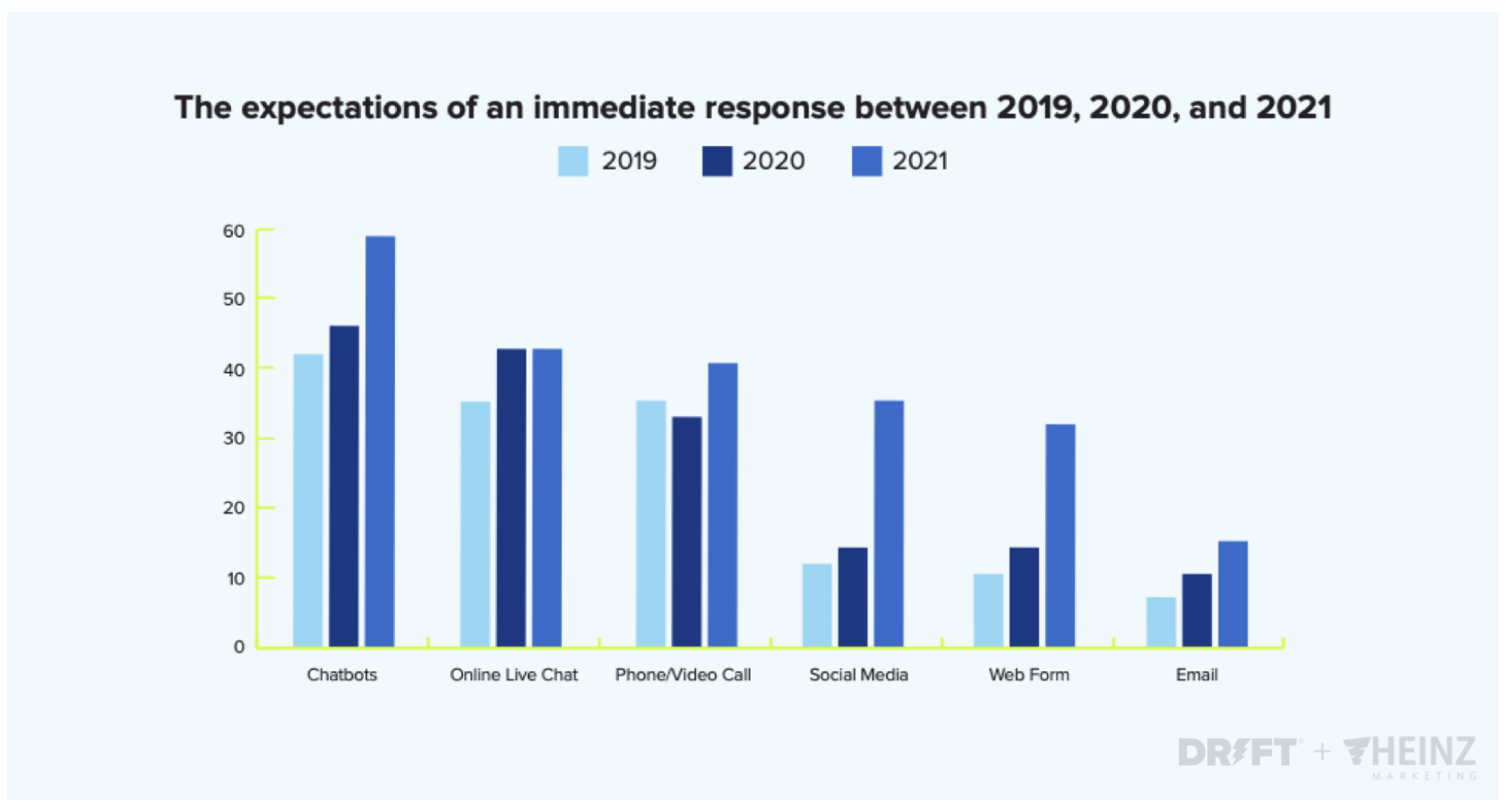Being in the B2B space, keeping up with technology and marketing trends is essential for distributors. For starters, most of their customers (if not all) have adopted these technologies and expect their providers to do the same. However, distributors are notoriously slow to adopt new technology.
One of the leading technologies that can help qualify leads and facilitate sales are chatbots. They have the ability to provide a personalized experience that is both convenient for customers and profitable for businesses. And, they’re not hard to set up and launch on your website.
~ 58% of B2B businesses use chatbots on their websites.
Why Chatbots?
Chatbots facilitate communication, help you stand out from competitors, generate leads, acquire new customers and increase repeat business.
With this technology, distributor businesses can provide customer service 24/7 without having to hire a dedicated team, and spend less money and time qualifying and managing each individual inquiry.
Some people may feel that having an obvious robot providing automated responses may be a turn off for visitors, but the opposite is true. The fact is, according to a recent study by Drift, 32% of consumers use chatbots to get immediate answers to a question.
Chatbots improve the customer experience by speeding up the response time, which is a critical factor in today’s market. This turns into increased sales and revenue for your business.
This study shows interesting results about the response expectation of chatbots versus other channels. Chatbots give you a clear competitive advantage as few distributors have adopted them as a marketing tool.
How Can Distributors Use Chatbots?
Chatbots can help you provide website visitors answers to common questions, find the right information on your site, request quotes, or connect with a sales rep. This also gives your rep a bit of time to prepare, decreasing the number of unanswered chats that tend to happen with a live chat feature.
Have Your FAQs Ready
Frequently asked questions are one of the best uses for chatbots. Instead of having to wait for a response via email or phone call, a visitor can have an answer right away which will help move them faster throughout the buying process.
Create a laundry list of questions using information collected from your clients’ interactions, CRM and email tools, marketing software, analytics, surveys and sales calls.
Each page of a website can have a different set of frequently asked questions as well. For example, you can answer product-specific questions with a chatbot on product pages or service-focused questions on your service page.
Adapt The Chat For Each Type of Page
Having the same script across all the pages on your website can make the visitor feel a disconnect. Simple adjustments for each page will increase relevance, engagement and conversions.
When a potential buyer lands on your home page, the chatbot should offer general options that will take them to the next step.
For example:
- Find particular category pages.
- Learn more about your company.
- Find promotional ideas on your blog
- Connect with a live sales rep.
But when they go to a specific service page, such as your kitting and fulfillment page, they will expect to find answers to questions related to that service. Here you’ll want to ask specific questions that will help you qualify the lead, such as:
- When is your deadline
- How many types of products, approximately, are you looking for your kit?
- How many packages are you looking to drop ship?
- Do you need us to store your products?
You get the idea.

Getting Started With Chatbots
There are two main types of chatbots: basic and advanced. Basic chatbots allow you to set pre-configured questions and answers. These include frequently asked questions or options for speaking with a rep. They are easier to set up and more affordable than the advanced, but they are limited in terms of how far you can take the conversation on the conversion path, as compared with the advanced chatbots.
Advanced chatbots are powered by artificial intelligence (AI) and machine learning (ML) which means they can learn from their interactions with users over time and provide more accurate responses. This provides customers with better personalized experiences which lead to increased conversions. As you would expect, AI chatbots are more expensive and complicated to set up.
If you want to get started with chatbots, the first step is to decide what chatbot solution will work best for your company. As a general rule, we recommend going with the simple one because it’s faster to implement and will allow you to start using them faster, and thus getting results faster as well.
There is a learning curve to adopting new technology and systems, starting with a simple solution just makes it easier to adopt. Plus you will see increased conversions just by getting conversations started, providing automatic responses to frequently asked questions and giving a live rep a chance to take over the chat and continue the conversation.
When you get to the point that you’re ready to take the chatbots to the next level, you can move to the advanced solution.
Best Practices
There are some things to consider when implementing a chatbot on your website to make it as effective as possible. Here are the most important ones.
Don’t Pretend It’s a Human
Some people try to make their bot appear like live chat. They think this will make it less robot-like and more personal, but it rarely works that way. Consumers are tech savvy and will realize your live chat is a bot and your credibility will suffer. It is best to be honest and let them know it’s your bot, after all, they’re totally fine interacting with bots, so why mess with the start of a relationship unnecessarily.
Use Your Customer’s Language
The best chatbots not only answer a potential client question but make them feel understood. Make sure you don’t use industry jargon and instead, use the words and phrases customers use when they communicate with your company. This will help the chatbot’s messaging resonate with them and they’ll be more likely to take action.
To achieve this, you need to do a little homework. Use conversations with your clients, sales calls, emails and social media conversations to get this information.
If your company chooses a chatbot with artificial intelligence, many solutions will optimize scripts based on each user’s interactions. Templates will be adjusted with words and phrases that customers use in real-time. With basic chatbots, you will have to adjust scripts manually.
Track Performance
What gets measured gets improved. The fact is, 55% of businesses using chatbots generate a greater volume of high-quality leads, according to Drift. But it has to be implemented the right way. Set parameters to monitor on a regular basis so you know what needs improvement.
Activities to monitor include:
- Number of bot conversations started and closed without any action taken
- Number of bot conversations that turned to customers
- How many people connected with a live rep through the bot.
- The average length of stay on the website
Chatbot software comes with analytics on some of the metrics you want to track, but you might want to add others from your company.
If you’re not getting much chat activity you want to test adding—or changing calls to action, tweaking scripts and experimenting with the location of the chatbot on your website.
One thing that helps a lot is asking your customers about their experience with the chatbot. These will be your most valuable insights.
The Point
Promotional products distributors have been late to adopt digital marketing trends and technology. Because few are using it, implementing the latest technology helps you stand out from the competition, drive more conversions and provide a better customer experience.
Get started by installing a chatbot system on your website, include a few basic questions to get going and make improvements later.
This article was first published in Action Marketing blog. For more marketing articles, free webinars and guides specific to the promo business, visit the Resources section of ActionMarketingCo.com.



